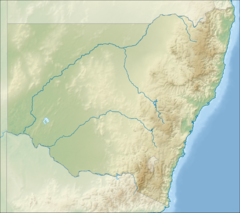Barrington Tops National Park
| Barrington Tops National Park | ||
|---|---|---|
| Barrington River | ||
|
|
||
| Location: | New South Wales , Australia | |
| Specialty: | Mountain landscape | |
| Next city: | Dungog | |
| Surface: | 743 km² | |
| Founding: | 1969 | |
The Barrington Tops National Park is a 745 km² national park in the Australian state of New South Wales , about 270 km north of Sydney .
Barrington Tops is a plateau that stretches between two peaks of the Mount Royal Ranges , part of the Great Dividing Range . It also forms the watershed between the Hunter and Manning Rivers . Barrington Tops is located on a volcano ; it reaches an altitude of 1586 m.
On December 3, 1969, the region between Mount Barrington , Mount Royal and the Gloucester Tops was declared a national park. Since 1982 the park has been listed as part of the Gondwana rainforests of Australia as a UNESCO World Heritage Site ; as such, it is the southernmost of the affiliated national parks.
history
The Barrington Tops area was home to various Aboriginal tribes , namely the Worimi and Biripi in the east and the Wonnarua in the west.
From around 1820, European settlers began to settle in the region, using the areas to cut logs and as grazing land for cattle. Gold was also searched here.
In the early 20th century, horse riding, hunting and fishing became popular for tourism. The Barrington Club , founded in 1948 , campaigned for nature conservation. In 1959 the first areas were placed under protection.
Ecosystems
The park includes ecosystems of tropical rainforest in the protected valleys and gorges at heights between 400 and 600 m. At an altitude of 700 to 1400 m there is cool temperate rainforest , where the Nothofagus moorei predominates. This is followed by an alpine zone with alpine woodland and subalpine peat bogs in the summit regions.
Eucalyptus forests with different species predominate across all heights : Sydney and Messmate eucalyptus dominate the valleys and on the slopes, and the southern beech also dominates the higher areas . On the other hand, the cold-resistant snow eucalyptus predominates on the plateau .
Thanks to the remote, inaccessible location of the park, a diverse fauna has been preserved, including some species that have already been considered extinct. A butterfly, three spider species, three worm species and the crustacean Crenoicus harrisoni are endemic to the park.
Also, coming Eastern Gray kangaroos , Rotnackenwallabys , Rotnacken Filander and common wombat before. Nocturnal mammals are u. a. Sleeping bags , nose bags and giant gliding bags . Also echidna and platypus find their habitat. The koala is difficult to observe, Pseudomys oralis is a very endangered species and the Australian wide-toothed rat is found only in a few places in Australia.
Birds include lyre-tails , cockatoos , flat-tailed parakeets , kookaburras , strangler crows and grouse . The black cockatoo is rarely seen. Reptiles are u. a. represented by the species black otter , tiger otter , copper-headed snake and brown snake .
Web links
- Official website of Barrington Tops National Park at environment.nsw.gov.au


